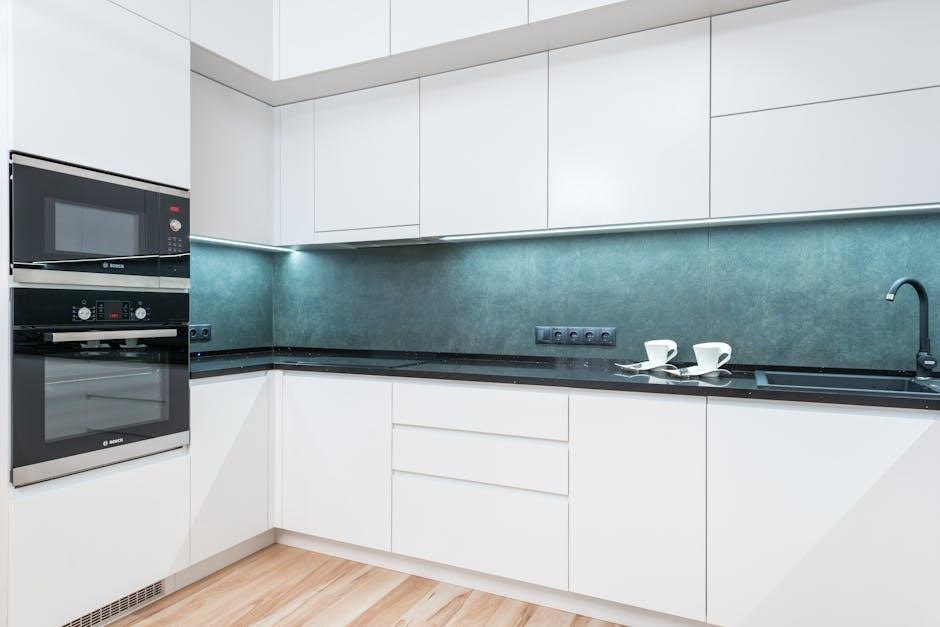Maintaining your GE Monogram oven is essential for optimal performance and safety. This guide provides a comprehensive approach to cleaning, ensuring a spotless and efficient appliance.
Overview of GE Monogram Oven Cleaning
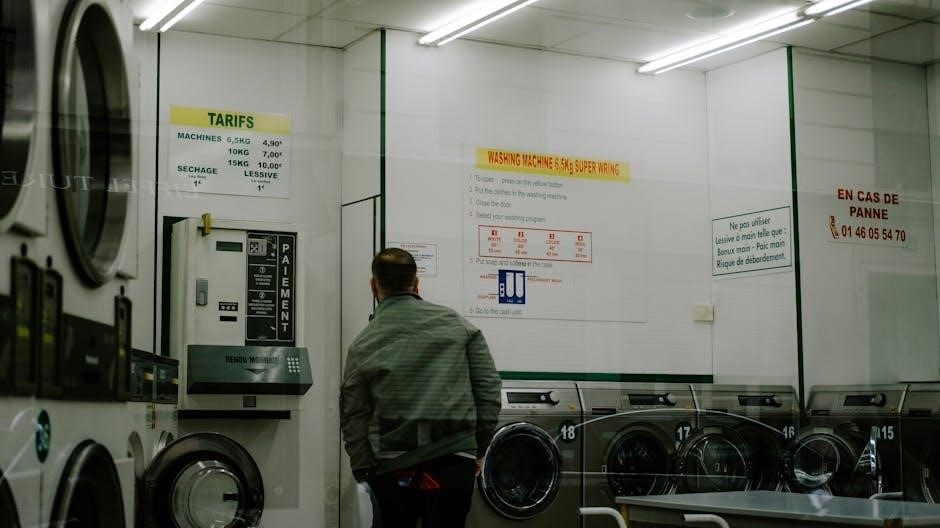
Cleaning your GE Monogram oven is a straightforward process that ensures longevity and maintains its sleek appearance. Designed with advanced features, these ovens require regular attention to remove food residue and grime. The process involves preparing the oven, using appropriate cleaning solutions, and tackling both exterior and interior surfaces. It’s important to follow a systematic approach to avoid damaging the appliance’s finish or components. While some owners prefer gentle methods, others may need deeper cleans depending on usage. Always refer to the manufacturer’s guidelines to ensure compatibility with cleaning products and techniques. This section provides a broad understanding of the cleaning process, setting the stage for detailed steps and expert tips to keep your GE Monogram oven in pristine condition.
Importance of Regular Oven Cleaning
Regular cleaning of your GE Monogram oven is crucial for maintaining its performance, efficiency, and safety. Food residue and splatters can build up over time, leading to unpleasant odors, smoke, and even fires. A clean oven ensures even heating, which is essential for consistent cooking results. Additionally, regular maintenance prevents grease and grime from becoming stubborn stains, making the cleaning process easier and less time-consuming. It also helps preserve the oven’s aesthetic appeal, keeping it looking like new. Neglecting cleaning can reduce the appliance’s lifespan and affect its energy efficiency. By prioritizing regular oven cleaning, you ensure a safer, healthier, and more enjoyable cooking experience while protecting your investment in a high-quality appliance like the GE Monogram.

Tools and Materials Needed
Essential tools include gloves, scrubbers, microfiber cloths, and a scraper. Optional items are baking soda, vinegar, and commercial cleaners. Always have water and towels handy.
Essential Cleaning Supplies
For effective GE Monogram oven cleaning, gather essential supplies like gloves, a sturdy scrubber, microfiber cloths, and a plastic scraper. Baking soda and white vinegar are natural cleaners, while a mixture of water and dish soap works for general grime. A long-handled brush can reach tough corners, and a sponge is ideal for wiping surfaces. Protective eyewear and a face mask are optional but recommended for safety. Avoid abrasive materials that might scratch the oven’s finish. Optional items include commercial oven cleaners, but always check compatibility with your appliance. These tools ensure a safe and thorough cleaning process, keeping your oven in prime condition for years to come.
Optional Cleaning Products
While essential supplies are sufficient for most cleaning tasks, optional products can enhance your GE Monogram oven cleaning experience. Commercial oven cleaners offer powerful stain removal but should be used cautiously, ensuring compatibility with your appliance. A steam cleaner is another option for a chemical-free deep clean. For tougher grime, a scouring powder can be effective when applied with a damp sponge. Microfiber cloths are excellent for polishing surfaces without streaks. If you prefer a fresh scent, adding a few drops of lemon juice or scented vinegar to your cleaning solution can leave a pleasant aroma. Optional protective gear like gloves and goggles can also make the process safer and more comfortable. These products provide flexibility for tailored cleaning routines.
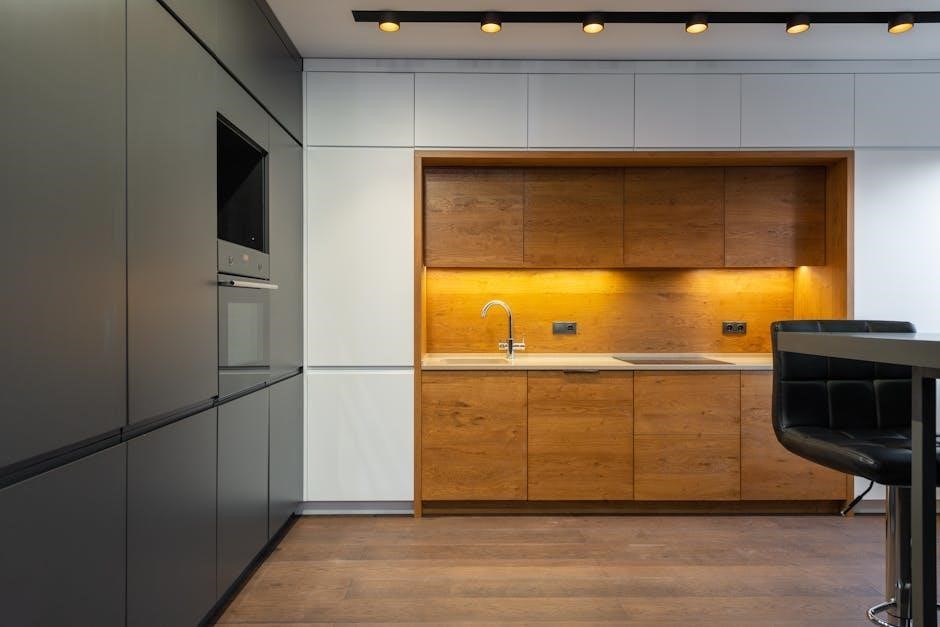
Step-by-Step Cleaning Process

A comprehensive guide to cleaning your GE Monogram oven, covering essential tasks from preheating to final polishing, ensuring a sparkling and hygienic appliance.
Preheating the Oven for Cleaning
Preheating your GE Monogram oven is a crucial first step in the cleaning process. Set the oven to 200-250°F (90-120°C) and let it heat for 20-30 minutes. This step helps soften tough food residue and grime, making it easier to remove during cleaning. Ensure the oven is empty and racks are removed before preheating. Avoid using abrasive cleaners or harsh chemicals during this phase, as they can damage the oven’s finish. Once preheated, turn off the oven and allow it to cool slightly before proceeding with manual cleaning. Always refer to your GE Monogram oven’s user manual for specific temperature recommendations, as settings may vary. This method ensures a safe and effective start to achieving a spotless oven interior.
Removing Oven Racks and Shelves
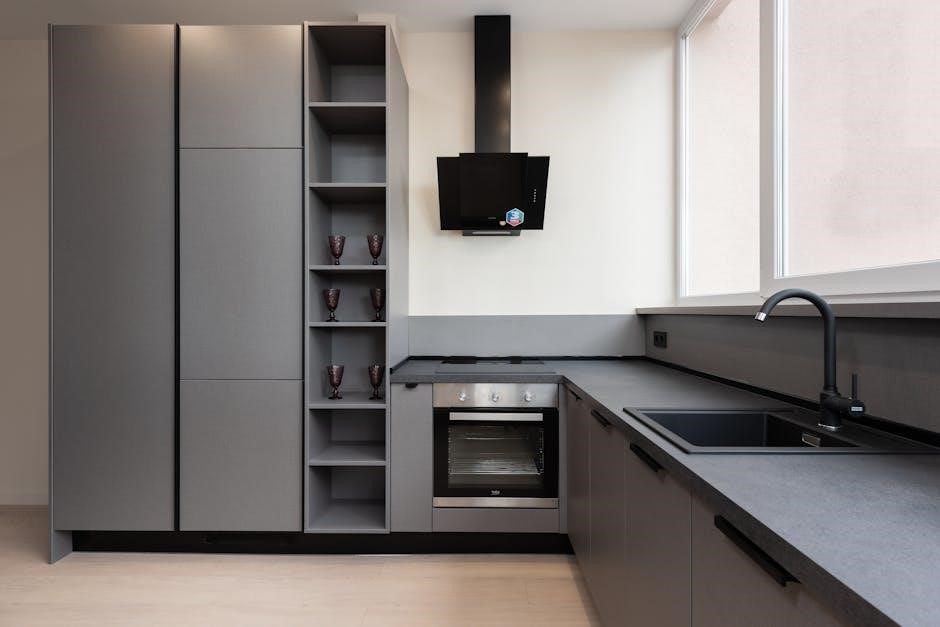
Before cleaning your GE Monogram oven, remove all racks and shelves to ensure easy access to the interior surfaces. Use oven mitts or tongs to protect your hands from sharp edges. Place the racks and shelves in a sink or large container filled with hot, soapy water to soak. This step allows tough food residue to loosen, making cleaning more efficient. For particularly stubborn stains, you can leave them to soak overnight. Once removed, set the racks and shelves aside to clean separately. This process prevents damage to the oven and ensures a thorough cleaning. Always refer to your GE Monogram oven’s manual for specific rack removal instructions, as designs may vary. Proper removal is essential for maintaining your oven’s performance and longevity.
Cleaning the Oven Window
Cleaning the oven window is crucial for maintaining visibility while cooking. Start by mixing a paste of baking soda and water. Apply the paste to the window using a soft cloth or sponge, ensuring full coverage. Allow the paste to sit for 15–20 minutes to loosen grime. Use a damp cloth to wipe away the paste and grime. For stubborn stains, repeat the process or use a gentle glass cleaner. Avoid using harsh chemicals or abrasive scrubbers, as they can damage the glass. Rinse thoroughly with warm water and dry with a clean cloth to prevent streaks. Regular cleaning prevents grease buildup and maintains a clear view. For tough stains, a mixture of equal parts water and white vinegar can also be effective. Always test a small area first to ensure no damage occurs.
Wipe Down the Oven Exterior
Cleaning the exterior of your GE Monogram oven is essential for maintaining its sleek appearance and preventing grime buildup. Start by mixing a solution of mild dish soap and warm water. Dip a microfiber cloth into the solution, wring it out thoroughly, and gently wipe down the exterior surfaces, including the control panel, knobs, and door handles. Avoid using harsh chemicals, abrasive cleaners, or scrubbers, as they may damage the finish. For tougher stains or splatters, let the soapy solution sit for a few minutes before wiping. Use a clean, damp cloth to remove any soap residue. For stainless steel surfaces, a small amount of vinegar can help eliminate fingerprints and smudges. Dry the exterior with a clean, dry cloth to prevent water spots. Regular wiping helps maintain the oven’s pristine look and prevents dirt from accumulating.
Cleaning the Oven Interior
Cleaning the interior of your GE Monogram oven involves addressing food residue, grime, and stains. Start by ensuring the oven is cool to avoid burns. Remove racks and shelves for separate cleaning. For light cleaning, use a damp microfiber cloth to wipe down surfaces. For tougher grime, apply a mixture of baking soda and water or a commercial oven cleaner, following the product’s instructions. Allow the solution to sit overnight or as directed. Use a stiff brush or scouring sponge to scrub away stubborn stains, working gently to avoid scratching surfaces. Avoid using abrasive cleaners or bleach, as they can damage the oven’s finish. Rinse thoroughly with a damp cloth and dry to prevent water spots. Regular interior cleaning ensures even heating and prevents food residue from burning onto surfaces during future use.
Scrubbing Tough Stains
Scrubbing tough stains requires a combination of the right tools and techniques. For stubborn grime, use a stiff-bristled brush or a scouring sponge to gently scrub the stained areas. Apply a small amount of baking soda paste or a commercial oven cleaner directly to the stains. Let it sit for 15–30 minutes to loosen the grime. Scrub in a circular motion, applying moderate pressure to avoid scratching the oven surfaces. For particularly resilience stains, repeat the process or use a steam cleaning method. Avoid using abrasive materials or bleach, as they can damage the oven’s finish. After scrubbing, wipe away the residue with a damp cloth and dry the area thoroughly to prevent water spots. Regularly addressing tough stains prevents them from hardening and makes future cleaning easier.
Cleaning Oven Racks and Shelves
Cleaning oven racks and shelves is a crucial step in maintaining your GE Monogram oven. Start by removing the racks and shelves, then wash them in warm soapy water or place them in the sink to soak. For tough food residue, mix baking soda and water to create a paste, and apply it to the racks. Let it sit overnight before scrubbing with a non-abrasive sponge or brush. For a quicker method, run the racks through a dishwasher cycle if they are dishwasher-safe. Once clean, rinse thoroughly and dry with a soft cloth to prevent water spots. Regular cleaning prevents grease and food particles from building up, ensuring your oven remains hygienic and functional. For heavily soiled racks, consider using a commercial oven cleaner, but avoid abrasive materials that could damage the finish.
Rinsing and Drying
Rinsing and drying are the final steps to ensure your GE Monogram oven is spotless and free from cleaning residue. After scrubbing the interior and racks, use a damp cloth to wipe away any cleaning solution or debris. For tougher residue, mix equal parts water and white vinegar in a spray bottle and mist the surfaces before wiping clean. Once rinsed, use a microfiber cloth to thoroughly dry the oven interior, racks, and shelves to prevent water spots. Pay extra attention to crevices and corners where moisture might linger. Allow the oven to air dry with the door slightly open to ensure all areas are completely dry. Regular rinsing and drying help maintain the oven’s finish and prevent mineral deposits from forming. This step ensures your oven is clean, hygienic, and ready for its next use.
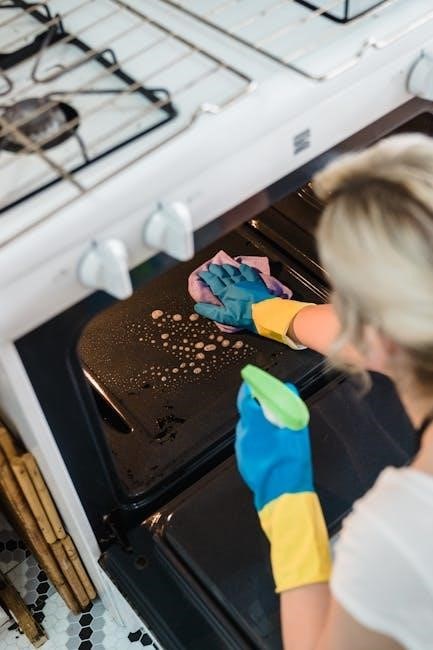
Maintenance Tips
Regular maintenance ensures your GE Monogram oven remains in pristine condition. Establish a consistent cleaning routine and adopt habits that prevent grime buildup, enhancing performance and hygiene.
Regular Cleaning Schedule
A regular cleaning schedule is crucial for maintaining your GE Monogram oven’s performance and hygiene. Aim to clean the oven weekly after heavy use or every two weeks for light use. Start by wiping down the exterior and interior with a damp cloth to remove surface grime. After each use, allow the oven to cool, then quickly wipe away food spills to prevent them from hardening. For deeper maintenance, set aside time each month to scrub the interior, clean racks, and tackle tough stains. Consistency is key to preventing grease buildup and ensuring your oven remains efficient and odor-free. By incorporating these habits into your routine, you’ll extend the lifespan of your appliance and keep it in pristine condition.
Using Protective Liners
Using protective liners is an excellent way to simplify GE Monogram oven cleaning and maintain its pristine condition. Place a silicone oven mat or heavy-duty aluminum foil at the bottom of the oven to catch food splatters and spills. These liners act as a barrier, preventing stubborn stains from forming and making cleanup much easier. For added convenience, reusable oven liners can withstand high temperatures and are easy to clean with soap and water. Replace disposable liners after each use to avoid grease buildup. This method not only reduces the need for harsh chemicals but also saves time during deep cleaning sessions. Always ensure the liner fits properly and does not block ventilation openings. By incorporating protective liners into your routine, you’ll keep your oven cleaner and extend its lifespan.

Deep Cleaning Techniques
Deep cleaning your GE Monogram oven involves advanced methods to tackle tough grime and odors, ensuring a thorough restoration of its performance and appearance.
Steam Cleaning Method
Steam cleaning is an effective and chemical-free way to deep clean your GE Monogram oven. Fill a heat-safe bowl with water and place it inside the oven. Set the oven to 200–250°F (90–120°C) for 20–30 minutes to create steam. Turn off the oven and let the steam loosen grime for 30 minutes. Once cooled slightly, use a damp towel to wipe down the interior surfaces. For tougher stains, repeat the process or use a scrub brush. This method is eco-friendly and prevents harsh chemicals from affecting the oven’s finish or your food. After cleaning, dry the surfaces thoroughly to prevent water spots. Regular steam cleaning helps maintain a clean and hygienic oven environment.
This technique is ideal for those who prefer a natural cleaning approach without abrasive chemicals.
Using Baking Soda and Vinegar
Cleaning your GE Monogram oven with baking soda and vinegar is a natural and eco-friendly method. Start by mixing 1 cup of baking soda with water to form a thick paste. Apply the paste evenly across the oven interior, avoiding heating elements. Let it sit overnight or for at least 8 hours. The next day, use a damp cloth to wipe away the loosened grime. For tough stains, spray vinegar directly on the area and scrub gently with a non-abrasive sponge. This method effectively breaks down grease and food residue without harsh chemicals. Rinse thoroughly with a clean, damp cloth and dry the surfaces to prevent water spots. This technique is ideal for maintaining a clean oven while ensuring safety and environmental sustainability.

Common Issues and Solutions
Grease buildup and stubborn stains are common challenges. Regular cleaning prevents grime accumulation. For odors, use baking soda or vinegar to neutralize smells effectively.
Tackling Grease Buildup
Grease buildup is a common issue in ovens, leading to unpleasant odors and potential fire hazards. To address this, mix baking soda and water to form a paste, applying it directly to greasy areas. Let it sit overnight before scrubbing with a stiff brush. For tougher spots, use a gentle cleanser or vinegar solution. Regular wiping of spills during cooking can prevent grease from hardening. Protective liners on the oven floor also catch drips, making cleanup easier. Avoid using abrasive cleaners or harsh chemicals, as they can damage the oven’s finish. Consistent maintenance ensures your GE Monogram oven remains free of grease and operates efficiently.
Removing Odors
Lingering odors in your GE Monogram oven can be unpleasant and affect the taste of your food. To eliminate these smells, start by identifying the source and cleaning thoroughly. Mix equal parts water and white vinegar in an oven-safe bowl, place it inside, and heat the oven to 200-250°F for 1-2 hours. This steam will help loosen and neutralize odors. For tougher smells, sprinkle baking soda liberally on the interior surfaces and let it sit overnight before wiping clean. Lemon juice can also be used as a natural deodorizer—place sliced lemons in the oven at a low temperature for 30 minutes. Always ensure good ventilation and wear gloves when cleaning. Regular deep cleans and prompt attention to spills will prevent odors from recurring, keeping your oven fresh and clean.
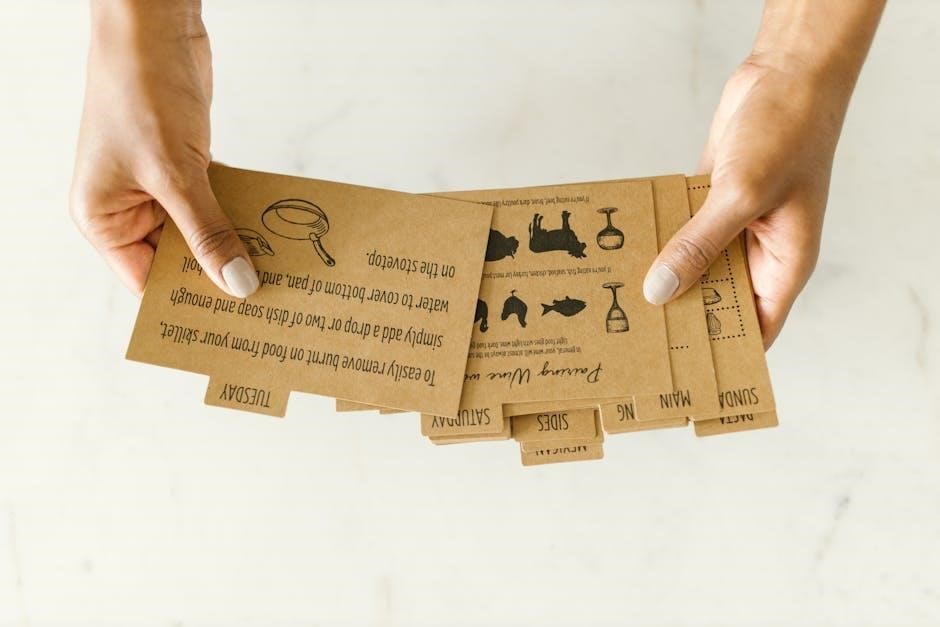
Safety Precautions
Ensure safety while cleaning your GE Monogram oven by avoiding harsh chemicals, maintaining proper ventilation, and wearing protective gloves. Always clean when the oven is cool.
Avoiding Harsh Chemicals
Avoid using harsh chemicals when cleaning your GE Monogram oven, as they can damage the finish or release harmful fumes during future use. Instead, opt for gentle, non-abrasive cleaners or natural alternatives like baking soda and vinegar. These methods effectively remove grime without risking damage to the oven’s surfaces. Always spot-test any cleaning solution on a small area first to ensure compatibility. For tougher stains, consider steam cleaning or prolonged soaking with a mild detergent. Remember to wear gloves and ensure good ventilation, even when using eco-friendly products, to protect your skin and respiratory health. Refer to your oven’s user manual for recommended cleaning agents to maintain warranty compliance and preserve the appliance’s longevity.
Proper Ventilation
Proper ventilation is crucial when cleaning your GE Monogram oven to prevent the buildup of harmful fumes. Always open windows and turn on exhaust fans to ensure good airflow. This helps dissipate any strong odors from cleaning products and maintains a safe environment. Avoid inhaling fumes from harsh chemicals or natural cleaners, as they can irritate respiratory systems. If using steam or vinegar, ensure the area is well-ventilated to prevent moisture from condensing on surrounding surfaces. Additionally, never use the oven until it is completely dry and free of lingering fumes. Proper ventilation not only enhances safety but also helps maintain the oven’s performance and your household’s air quality. Always prioritize fresh air circulation during and after the cleaning process.
Regular cleaning and proper maintenance ensure your GE Monogram oven performs efficiently and safely. By following these steps, you’ll maintain its quality and enjoy a pleasant cooking experience.
Final Tips for a Sparkling Oven
For a consistently clean GE Monogram oven, adopt a proactive cleaning routine. Wipe down surfaces after each use to prevent food residue buildup. Use gentle, non-abrasive cleaners to avoid damaging the finish. Regularly inspect and clean the oven vent to ensure proper airflow. To maintain a fresh smell, place a small bowl of lemon juice or white vinegar inside the oven during low-temperature baking. Avoid harsh chemicals, as they can harm the oven’s interior or release harmful fumes. For tough stains, let cleaning solutions sit overnight before scrubbing. Always refer to your user manual for specific care instructions tailored to your model. By incorporating these habits, your oven will remain in pristine condition, enhancing both its functionality and longevity.
